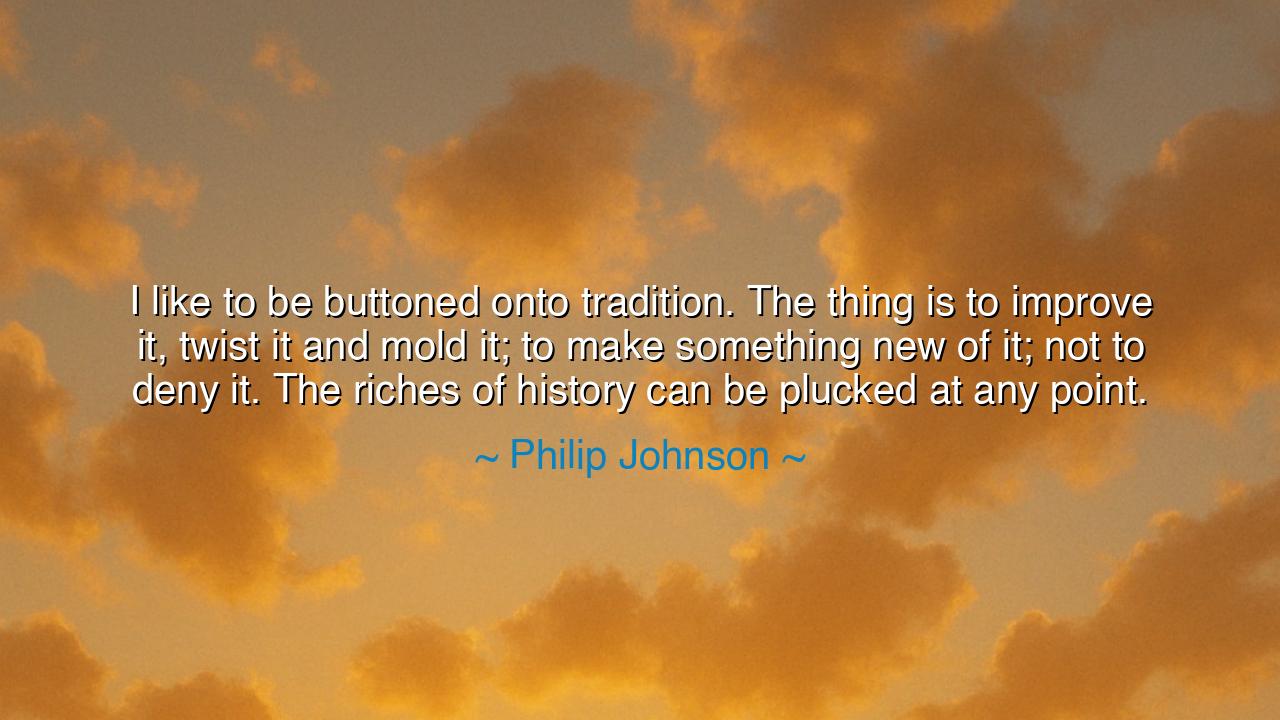
I like to be buttoned onto tradition. The thing is to improve it
I like to be buttoned onto tradition. The thing is to improve it, twist it and mold it; to make something new of it; not to deny it. The riches of history can be plucked at any point.






When Philip Johnson, the master of glass and form, said, “I like to be buttoned onto tradition. The thing is to improve it, twist it and mold it; to make something new of it; not to deny it. The riches of history can be plucked at any point,” he spoke as one who had walked the long corridor between the ancient and the modern — one who saw in the past not a prison, but a treasury. His words shimmer with reverence and rebellion, joined as one. For Johnson understood that tradition is not a weight to be cast aside, but a foundation upon which new dreams are built. The past, he teaches, is not dead — it is living clay, waiting to be shaped anew by the imagination of each generation.
The origin of this quote lies in Johnson’s lifelong dialogue with history. As one of the most influential architects of the twentieth century, he built his reputation on both honoring and transforming the styles that came before him. From the Glass House in New Canaan — a hymn to modernism inspired by Mies van der Rohe — to the AT&T Building in New York, where he revived the ornament of classical architecture in bold defiance of minimalist convention, Johnson proved that innovation and tradition need not be enemies. He saw architecture not as a rejection of the past, but as a conversation with it — a continuity of spirit, where the old lends wisdom to the new.
In his declaration, Johnson draws from the ancient truth that all creation is inheritance. The artist, the thinker, the builder — none begin from nothing. Each inherits a lineage of ideas, forms, and voices, and it is through engaging with that lineage that greatness is born. Just as a river draws its strength from its source, so too does creativity draw power from the traditions that precede it. To be “buttoned onto tradition” is not to be bound by it, but to be connected — to fasten oneself to the wisdom of those who came before, so that the wind of change does not scatter one’s purpose into vanity or chaos.
History itself proves the power of this principle. When Michelangelo painted the ceiling of the Sistine Chapel, he did not abandon the techniques of his predecessors — he deepened them. When Beethoven composed his symphonies, he did not reject the classical forms of Mozart and Haydn — he expanded them into realms of thunder and light. Even in rebellion, the greats remain rooted. The Renaissance was born not of denying antiquity, but of rediscovering it; the Enlightenment drew strength from the ancient Greeks; and the modernists, for all their iconoclasm, built their towers upon the ruins of Rome. The truly original mind, Johnson reminds us, is not the one that forgets history, but the one that remembers it creatively.
And yet, Johnson’s words also carry a challenge — to improve, twist, and mold what has been handed down. Tradition without innovation becomes stagnation, a monument to yesterday that forgets tomorrow. He urges us not to worship the past as a relic, but to treat it as raw material. To pluck the riches of history “at any point” is to be bold enough to draw inspiration from every age — from the ancient temple and the modern machine alike — and to fuse them into something that belongs uniquely to the present moment. The past, he suggests, is an open garden; its fruits belong to all who have the courage to cultivate them anew.
In this way, Johnson’s philosophy transcends architecture and speaks to all who create, lead, or live with purpose. The artist must respect the brushstrokes of the masters, but also dare to paint over them. The writer must listen to the echoes of old voices while finding her own song. The builder, the scientist, the philosopher — each must be both student and sculptor of the traditions that sustain them. To deny tradition is to cut the roots of one’s own tree; to honor and reshape it is to let that tree bear new fruit for generations to come.
So, O seeker of craft and wisdom, take heed of Philip Johnson’s teaching. Do not scorn what has come before you. Study it, learn from it, and let it ignite your imagination. Look upon the riches of history not as dust, but as gold waiting to be reforged. For every age must renew its inheritance, transforming what was into what must be. The fire of creation is not born from rejection, but from transformation — from taking the stones of the old world and building the temples of the new.
In this lies the eternal cycle of progress: to be rooted in reverence yet fearless in renewal. Let the past be your compass, not your cage. Let tradition fasten you, but never fasten you down. For as Philip Johnson knew, the glory of creation lies not in denying what has been, but in making it live again — twisted, molded, and reborn into the light of a new age.






AAdministratorAdministrator
Welcome, honored guests. Please leave a comment, we will respond soon